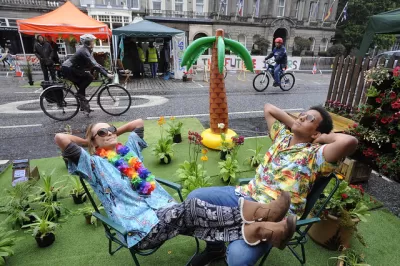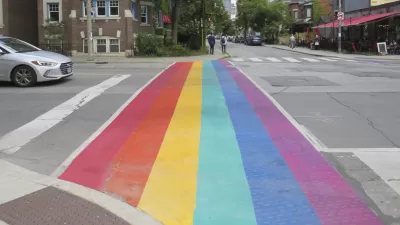Planopedia
Clear, accessible definitions for common urban planning terms.
What Is Tactical Urbanism?
Tactical urbanism, one of the most common buzzwords in planning over the past decade, describes a variety of low-cost, incremental public realm design interventions.

The book Tactical Urbanism: Short-Term Actions for Long-Term Change defines tactical urbanism as "an approach to neighborhood building and activation using short-term, low-cost, and scalable interventions and policies." Because the book was co-authored by Mike Lydon, who is also credited for coining the term, that definition for tactical urbanism comes as close to an authoritative as any for the many planning terms included in Planopedia.
Despite the authoritative definition, tactical urbanism can take on many forms across a spectrum of formality ranging from do-it-yourself design interventions to projects planned and permitted by public agencies. Tactical urbanisms usually take place on or around streets—in the public realm of communities—ranging from pop-up parks to open streets programs to PARK(ing) Day, parklets, DIY bike lanes, crosswalk art, temporary bus lanes, and more. Tactical urbanism projects are flexible and low-cost to make incremental improvements toward larger visions, Tactical urbanism projects are often also temporary, to test design ideas on the way to permanent changes or to pressure government agencies to act.
Tactical urbanism is sometimes described with terms like guerrilla urbanism, pop-up urbanism, city repair, D.I.Y. urbanism, planning-by-doing, urban acupuncture, and urban prototyping, indicating the meaning of the term that implies a process of reclaiming the power to transform public spaces from elected officials, public sector bureaucrats, and private sector financial interests. The "guerrilla" aspect of tactical urbanism comes from its traditional focus on raising attention to issues, such as traffic safety or a lack of open space, where the public or private sectors have failed to account for desires and needs of the public. Tactical urbanism is the latest iteration of a long history of citizen-led efforts to alter streets or spaces without the permission of government agencies, sometimes leading to sustained and sanctioned change at the policy level. Very recently relative to this writing, in fact, a group known as the Crosswalk Collective LA began painting crosswalks in Los Angeles without permission from the city agencies that control street design and traffic controls. The city eventually removed the crosswalks.
As the term has gained traction in the media and public consciousness, advocates like Lydon have expanded the concept to accommodate formal planning and design powers. This concept of tactical urbanism shifts the focus of tactical urbanism from short-term, unpermitted activities to incremental projects that contribute to long-term goals and permanent changes. The definition of tactical urbanism, therefore, has come to include processes for governments and communities to test new ideas, bringing to life concepts previously only available on paper or in distant locations.
The Streets Plans collaborative, founded by Lydon and Tactical Urbanism co-author Anthony Garcia, accommodates the spectrum of tactical urbanism applications by identifying five common characteristics of tactical urbanism projects:
- A deliberate, phased approach to instigating change;
- The offering of local solutions for local planning challenges;
- Short-term commitment as a first step towards longer-term change;
- Lower-risk, with potentially high rewards; and
- The development of social capital between citizens and the building of organizational capacity between public and private institutions, non-profits, and their constituents.
Lydon and Garcia cite long-term goals to exclude activities like yarn bombing, eye bombing, seed bombing, and some forms of DIY art from the definition of of tactical urbanism, describing them instead as “opportunistic placemaking.”
Lydon and Garcia acknowledge their role in branding the term, so some of the boundaries they've set on the definition of tactical urbanism obviously serve the interests of their work through the Street Plans collaborative. However, tactical urbanism has its own momentum as a fundamentally liberating activity—sometimes as a for of civil disobedience—expressed with a great deal of freedom in the what, where, and how it takes place.
Tactical Urbanism and Equity
The effort to convert street space for outdoor recreation in the early months of the Covid-19 pandemic produced swift, almost ubiquitous victories in living memory for the concepts of tactical urbanism over the car-centric planning status quo. The usual vice grip of NIMBYs on parking and development politics had suddenly vanished. In its place, slow streets, open streets, al fresco streets, and dining parkelts popped in cities all over the United States and world.
However, the swift adoption fo these programs, without feedback from low-income communities and communities of color, was a primary complaint in a public reckoning about the assumptions of ostensibly progressive planning ideals after police officers murdered George Floyd and Breonna Taylor.
Mike Lydon and Anthony Garcia responded to the need to center equity in tactical urbanism projects in a detailed interview with Kea Wilson of Streetsblog USA—and certainly the need for more equitable planning processes is not solely their responsibility. The effort to ensure that tactical urbanism delivers appropriate benefits to the neighborhoods and communities with the most need continues, however, as evidenced by a recent (as of this writing) article written by Consuelo Araneda and published by Arch Daily.






























